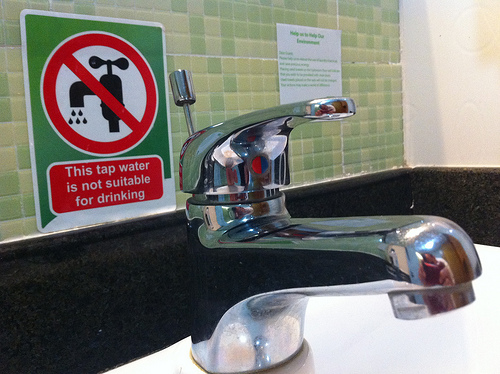 Photo: Wayan VotaThere are many hardships in the life of American farmworkers. One of the more shocking and pernicious of these is highlighted in a recent Fresno Bee series called “Don’t Drink the Water”: Many rural residents don’t have access to safe, clean drinking water.
Photo: Wayan VotaThere are many hardships in the life of American farmworkers. One of the more shocking and pernicious of these is highlighted in a recent Fresno Bee series called “Don’t Drink the Water”: Many rural residents don’t have access to safe, clean drinking water.
Reporter Mark Gross went to Tulare Country in California’s Central Valley (our nation’s produce capital) to investigate reports of high nitrate contamination. This is the same area a U.N. water quality investigator visited recently, after stopping in Bangladesh, Uruguay, and Namibia to look at “social problems linked to a lack of access to clean water.” Things were so bad in Tulare County, said the U.N. investigator, that he “urged state and federal authorities to consider healthy drinking water a human right and clean up the mess.”
An estimated 95 percent of Central Valley residents drink bottled water, spending far more of their income on water than most people. Gross cites a study from the University of California, Berkeley and published in Environmental Health Perspectives that determined “poverty-level Latinos are the population group most affected by the degraded water. ‘Those who are the least able to cope with drinking water contamination face some of the biggest exposure threats,’ said lead researcher Carolina Balasz.”
Nitrates can cause dizziness, gastrointestinal problems, a potentially fatal infant disease called methemoglobinemia (aka “blue-baby syndrome”), and possibly cancer. While nitrates are naturally occurring (often coming from decaying vegetable matter), it’s the Central Valley’s vast agricultural production that has caused the contamination problem there. While manure from factory livestock farms was once considered the main culprit, attention has now shifted to nitrogen fertilizer runoff from farm fields.
Grist published a primer on the many problems associated with nitrogen pollution last year. The Fresno Bee simply confirmed how little has changed. It’s a human tragedy that would be cheap to fix, but, sadly, it appears to be low on the list of priorities for the state. As Gross observes:
[I]t wouldn’t take a lot of money to clean up the Valley’s small-town water problems — $150 million total for projects on record. San Francisco last year committed the same amount of money to help homeowners and businesses finance solar panels and water efficiency.
The more difficult challenge is addressing the sources of the pollution. Even if all industrial farms were shut down today, “nitrate plumes” in the water table would likely persist for decades. That hasn’t kept California from trying; new regulations designed to penalize farms that use nitrogen inefficiently in high-risk areas are going into effect. But as Stephanie Ogburn concluded in Grist’s nitrogen series, reducing nitrogen fertilizer use is a tricky business. Farmers are rewarded for high yields, not for preserving natural resources, and penalizing them for overusing fertilizer without providing significant aid is a recipe for regulatory disaster.
What we should do is provide real incentives for farmers to move away from the monocropping style of agriculture that relies so heavily on synthetic fertilizer in order to provide soil nutrients. For example, the Rodale Institute has found in a 30-year trial — whose conclusions have been relentlessly downplayed by the USDA and other advocates for industrial agriculture — that sustainable, organic agriculture can be as productive as conventional farming, more environmentally sound, and more lucrative. That said, even incentivizing farmers to return to traditional crop rotations (which alternate nitrogen-depleting crops like corn with nitrogen-fixing crops like soy or alfalfa) would represent a huge improvement.
This problem will require sticks and carrots. Yet it appears that sticks are much more common, which is too bad, because the stakes are awfully high for the people who live in our rural areas. As a former California state representative who has been working on water issues for years put it: “These are forgotten communities of people. They need help now.”



